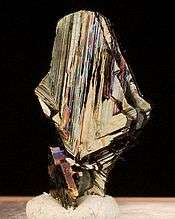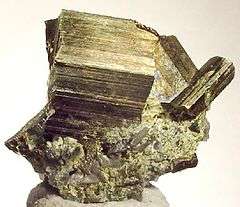Cubanite
| Cubanite | |
|---|---|
|
Striated, cyclically-twinned cubanite crystals from the Chibougamau mines of Quebec. (size: 1.5 x 1.3 x 1.0 cm) | |
| General | |
| Category | Sulfide mineral |
| Formula (repeating unit) | CuFe2S3 |
| Strunz classification | 2.CB.55a |
| Crystal system | Orthorhombic |
| Crystal class |
Dipyramidal (mmm) H-M symbol: (2/m 2/m 2/m) |
| Space group |
Orthorhombic Space group: Pcmn |
| Unit cell |
a = 6.467(1) Å, b = 11.117(1) Å, c = 6.231(2) Å; Z = 4 |
| Identification | |
| Color | Bronze to brass-yellow |
| Crystal habit | Crystals elongated to thick tabular, striated also massive |
| Twinning | Common with twin plane {110} in pairs, also as fourlings and pseudohexagonal sixlings |
| Cleavage | Parting on {110} and {130} |
| Fracture | Conchoidal |
| Mohs scale hardness | 3.5-4 |
| Luster | Metallic |
| Streak | Black |
| Diaphaneity | Opaque |
| Specific gravity | 4.0-4.2 |
| Optical properties | Distinctly anisotropic on polished surface |
| Other characteristics | Strongly magnetic |
| References | [1][2][3] |

Iridescent and highly lustrous brass-yellow cubanite crystal from Chibougamau, Quebec (size: 1.7 x 1.0 x 0.7 cm)
Cubanite is a yellow mineral of copper, iron, and sulfur, CuFe2S3.[3]
Cubanite was first described in 1843 for an occurrence in the Mayarí-Baracoa Belt, Oriente Province, Cuba.[1]
Cubanite occurs in high temperature hydrothermal deposits with pyrrhotite and pentlandite as intergrowths with chalcopyrite. It results from exsolution from chalcopyrite at temperatures below 200 to 210 °C.[2] It has also been reported from carbonaceous chondrite meteorites.[2]
References
- Schumann, Walter (1991). Mineralien aus aller Welt. BLV Bestimmungsbuch (2 ed.). p. 223. ISBN 3-405-14003-X.
| Wikimedia Commons has media related to Cubanite. |
This article is issued from Wikipedia - version of the 10/11/2016. The text is available under the Creative Commons Attribution/Share Alike but additional terms may apply for the media files.
